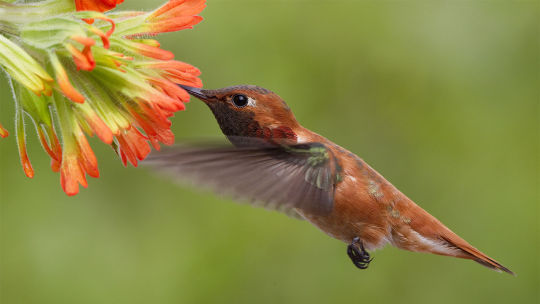Photo

Hummingbirds can count their way to food
Tiny, feisty rufous hummingbirds are known for their long migrations, which take them up and down the length of North America each year. Now, they have a new claim to fame: They can keep track of particularly juicy flowers depending on where they appear—first, second, or even fourth—in a line-up of blooms. Although this understanding of “numerical order” may sound simple, it’s a complex skill that may help hummingbirds remember the easiest routes between nectar-rich flowers. It’s also the first time researchers have seen the ability in a wild vertebrate.
375 notes
·
View notes
Video
youtube
How flying snakes stay stable while gliding through the air
Flying snakes glide through the air, flattening their bodies to provide lift. But as they glide they seem to swim, undulating their bodies from side to side. Now a team in the United States has used motion capture technology to study snake gliding in precise detail. Their models reveal that undulation is vital for the snake’s stability as they glide from branch to branch.
246 notes
·
View notes
Photo

‘Ghost fleas’ bring toxic mercury up from the depths of prairie lakes
How toxic mercury moves through the environment—and accumulates in the fish that people eat—has been known for decades. Now, scientists have discovered an unexpected way that the neurotoxin circulates in lakes, hitching a late-night ride inside small predatory crustaceans dubbed “ghost fleas.” The finding helps explain why some lake fish contain surprising amounts of mercury. It also suggests researchers who sample lakes only during the day might be missing important clues to how those ecosystems work.
247 notes
·
View notes
Photo

'Like Poking a Beehive': The Worrisome Link Between Deforestation And Disease
"When you disturb a forest, it actually upsets, if you want, the balance of nature, the balance between pathogens and people."
257 notes
·
View notes
Photo

Deep-sea currents are behind the ocean’s thickest piles of microplastics
They found an average of 41 pieces in each spoonful of sediment from continental shelves. That number dropped to just nine pieces deeper down on the continental slope. But when scientists sampled piles of sediment that build up in the deep ocean, adjacent to fast-flowing currents, they found 190 pieces of microplastics per spoonful of sediment, the highest concentration of microplastics from the sea floor to date, they report this month in Science.
That amount—which adds up to 1.9 million pieces of microplastic per square meter—is likely dumped by the fast-flowing currents, meaning deep-sea circulation plays a role in where microplastics are deposited. These currents also bring vital nutrients and oxygen to the sea floor, scientists say, suggesting microplastic hot spots could overlap with areas rich in biodiversity. As researchers embark on expeditions to survey different areas on the sea floor—like submarine canyons and fans—they may just find the next hot spot.
132 notes
·
View notes
Photo

Great! They’ve solved the dying bee problem. :(
Blowing bubbles: Soapy spheres pop pollen on fruit trees
Japanese researchers have succeeded in fertilising pear trees using pollen carried on the thin film of a soap bubble.
They've been searching for alternative approaches to pollination, because of the decline in the number of bees worldwide.
When fired from a bubble gun, the delicate soapy spheres achieved a success rate of 95%.
The researchers are now testing drones that fire bubbles for pollination.
600 notes
·
View notes
Photo

Fighting fish synchronize their moves—and their genes
Okada and colleagues videotaped more than a dozen hours of fights between 17 pairs of fish and then analyzed what happened—and when—in each fight. The longer the fight, the more the fish synchronize their behavior, timing their circling, striking, and biting more than anyone had ever realized, the researchers report today in PLOS Genetics.
132 notes
·
View notes
Photo

Like humans, these big-brained birds may owe their smarts to long childhoods
Human beings typically don’t leave the nest until well into our teenage years—a relatively rare strategy among animals. But corvids—a group of birds that includes jays, ravens, and crows—also spend a lot of time under their parents’ wings. Now, in a parallel to humans, researchers have found that ongoing tutelage by patient parents may explain how corvids have managed to achieve their smarts.
587 notes
·
View notes
Photo

Millions of periodical cicadas to emerge in parts of US
After spending 17 years underground, millions of cicadas will be emerging in parts of the United States.
Periodical cicadas are expected to come out in early summer across southwest Virginia, parts of North Carolina, and in West Virginia.
As many as 1.5 million of the insects can emerge per acre of land.
While they are some of the longest-lived insects in the world, periodical cicadas spend almost their entire lives underground as what entomologists call "nymphs".
They live in the soil and feed on tree roots for periods of either 13 or 17 years depending on the species, according to Virginia Tech university.
174 notes
·
View notes
Photo

First U.S Woman To Walk In Space Dives To Deepest Point On Earth
"As a hybrid oceanographer and astronaut this was an extraordinary day, a once in a lifetime day."
301 notes
·
View notes
Photo

Epic 7,500-mile cuckoo migration wows scientists
Using a satellite tag, scientists have monitored a cuckoo that has just flown more than 7,500 miles (12,000km) from southern Africa to its breeding ground in Mongolia.
The bird has survived ocean crossings and high winds after traversing 16 countries.
145 notes
·
View notes
Photo

Urban foxes may be self-domesticating in our midst
In a famous ongoing experiment started in 1960, scientists turned foxes into tame, doglike canines by breeding only the least aggressive ones generation after generation. The creatures developed stubby snouts, floppy ears, and even began to bark.
Now, it appears that some rural red foxes in the United Kingdom are doing this on their own. When the animals moved from the forest to city habitats, they began to evolve doglike traits, new research reveals, potentially setting themselves on the path to domestication.
271 notes
·
View notes
Video
Image of the Week – June 8, 2020
CIL:12375 - http://cellimagelibrary.org/images/12375
Description: Movie showing the dynamics of kinetchore microtubules during meiosis II in primary spermatocytes of the crane-fly Nephrotoma suturalis that were experimentally flattened. Time-lapse polarization microscopy using a Nikon Microphot SA, equipped for liquid crystal polarized light microscopy (LC-PolScope, CRi, Woburn Massachusetts) 60x/1.4 PlanApo oil immersion objective, 1.4 NA oil imm. condenser, with 2.0x zoom lens. Images captured every 15 sec using a QImaging Retigo EXi CCD camera. Raw images were processed using 5-frame algorithm (Shribak and Oldenbourg, 2003). The time series used for the movie is included in this grouped set.
Authors: James R. LaFountain and Rudolf Oldenbourg
Licensing: Public Domain: This image is in the public domain and thus free of any copyright restrictions. However, as is the norm in scientific publishing and as a matter of courtesy, any user should credit the content provider for any public or private use of this image whenever possible.
238 notes
·
View notes
Photo

Part 2 of the antibody testing graphics looks at how different types of antibody test work.
Larger image and PDF download (and a bit more detail on the current coronavirus antibody tests) in the accompanying post: https://ift.tt/378gzln https://ift.tt/3cFpYSV
253 notes
·
View notes
Photo

SLOPPY SCIENCE 101! Do the work before you publish.
Two elite medical journals retract coronavirus papers over data integrity questions
“Our independent peer reviewers informed us that Surgisphere would not transfer the full dataset, client contracts, and the full ISO audit report to their servers for analysis as such transfer would violate client agreements and confidentiality requirements,” making the outside audit of the data impossible, the three co-authors wrote in the retraction statement. “Based on this development, we can no longer vouch for the veracity of the primary data sources.”
106 notes
·
View notes
Photo

Can Mail Spread the Novel Coronavirus?
“People should not be concerned, she says. SARS-CoV-2 “is very short lived on porous surfaces,” such as cardboard and paper. Once outside the body, the virus is easily rendered non-infectious, because its fragile lipid envelope can be damaged or destroyed with alcohol, soap or ultraviolet light, she says. “The guts of the virus, the genome and the protein wrapping it will be exposed,” which renders it unable to reproduce, she says. “
108 notes
·
View notes
